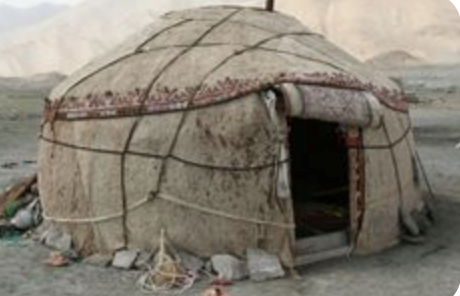(A)
The people who inhabit 24th century Antarctica – I call them the Onwei – all migrated from different parts of the Southern Hemisphere over the previous 300 years. During most of the year, they live in settlements near the coast and lack the technology to communicate with other villages. The only time they get together is for an all-tribes festival, the midsummer Rendezvous, in perpetual daylight, at centrally located Lake Tal. There, they trade clothing (A), arts, crafts, and horses (B), their main form of transportation. They recite stories, perform music and dances, read fortunes, eat fast food, drink yerba maté (C) or pulce beer, and generally carouse until exhausted, when they retire to their yurts (D) for a few hours rest.

Now consider: Is 300 years enough time to develop a distinct Onwei culture?
The broader question is: What makes a culture unique?
Living in isolation?
Native American, First Nations (Canada) and other New World tribes developed independently over perhaps 10,000 years of isolation, first from their ancestors in the Old World, then from each other over the vast expanses of the Americas in which they settled. Likewise Australian Aborigines. Contact with technologically advanced whites of European ancestry did not bode well for any of these groups.
Erebus Tales explores this theme.

A common enemy?
The increasing cohesion of virtually all countries in Central and Western Europe is a good example. Recurring threats from an expansionist Russia has brought together countries that fought two world wars against each other not that long ago. Think of it. NATO and likely the European Union owe their start to the prevailing menace, the big bear next door.
The common enemy in Erebus Tales is a force of nature (enough said; no spoilers).

A common language?
It took 100 years after America declared independence from Great Britain for the two countries to return to friendly terms, but now the U.S. and U.K. count each other as the closest of allies. English has become the international language of business and politics, now spoken by a billion people whose native tongue is different.
The dialects spoken by the Onwei still reflect those spoken by ancestors who first peopled the continent (primarily Spanish and English), but a hybrid tongue is emerging.
A common religion?
Various coercive methods have been used against minority religions, when the state supports a different religion, or is officially atheistic. Examples:
- Jews have been driven into exile, either as captives or through a diaspora, since biblical times. What has kept them cohesive is their rites and customs (e.g. keeping the sabbath, circumcision, kosher dietary practices), part of a covenant they made with their god Yahweh; they are the Chosen People. Yet, their refusal to assimilate makes them an easy scapegoat when times get tough.
- Early Christianity spread surreptitiously throughout the Roman Empire, but within 300 years, had itself become the state religion.
- The Uyghur of East Turkestan, now a part of China. Muslims like other Turkic peoples, with their own language, they are being “re-educated”, forced to integrate into the majority Han culture of China.
- Anabaptist sects grew out of the radical wing of the Reformation in 16th-century Europe. Their descendants – Amish, Hutterite, Mennonite, Brethren – many of whom settled in the U.S., sparked our principle of separation of church and state.
The Onwei religion is the Venga ceremony (see “Shaman” and “Dreamtime” posts). Joaquin later arrives at his own vision, to use the telepathic properties of Venga in uniting the tribes.

